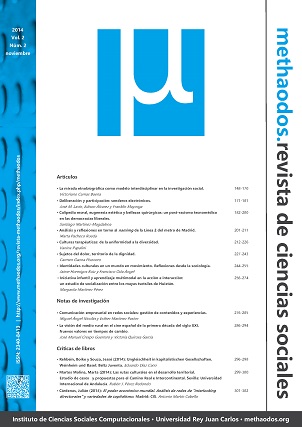Deliberation and participation: Electronic pathways
Main Article Content
Abstract
This paper describes how to apply the ICTs into the model of Deliberative Democracy to achieve legitimacy in decision making. To do this, we will discuss the Deliberative Model and how we can add participation instruments to improve the Deliberative Model and to include social or cultural stratum that are not contained in this model. Finally, we will see which electronic ways may help to create conditions for Deliberative model, using or not the Internet.
Downloads
Article Details
References
Albrecht, S., Kohlrausch, N., Kubicek, H., Lippa, B., Märker, O., Trénel, M., Vorwerk, W., Westholm, H. y Wiedwald, C. (2008): eParticipation – Electronic Participation of Citizens and the Business Community in eGovernment. Study on Behalf of the Federal Ministry of the Interior. Bremen: Institut für Informations Management.
Anduiza, E., Cantijoch, M. y Gallego, A. (2009): “Political participation and the Internet”, Information, Communication & Society, 12 (6): 860-878. http://dx.doi.org/10.1080/13691180802282720
Anduiza, E., Gallego, A. y Cantijoch, M. (2010): “Online Political Participation in Spain: The Impact of Traditional and Internet Resources”, Journal of Information Technology & Politics, 7 (4): 356-368. http://dx.doi.org/10.1080/19331681003791891
Bessette, J. (1980): “Deliberative democracy: the majority principle in Republic government”, en Goldwin, R. y Schambra, W. Eds.: How Democratic is the Constitution? Washington: American Enterprise Institute.
Bobbio, N., Matteucci, N. y Pasquino, G. (2004): Diccionario de la política. México DF: Editorial Siglo XXI.
Bohman, J. (1998): “Survey Article: The coming of the age of Deliberative Democracy”, Journal of Political Philosophy, 6 (4): 400-425. http://dx.doi.org/10.1111/1467-9760.00061
Brown, M. (2006): “Citizen Panels and the concept of Representation”, Journal of Political Philosophy, 14: 203-225. http://dx.doi.org/10.1111/j.1467-9760.2006.00245.x
Coglianese, G. (2007): “Assessing Consensus: The Promise and Performance of Negotiated Rulemaking”, Duke Law Journal, 46 (6): 1255-1349.
Coleman, S. y Moss, G. (2012): “Under Construction: The Field of Online Deliberation Research”, Journal of Information Technology & Politics, 9 (1): 1-15. http://dx.doi.org/10.1080/19331681.2011.635957
Collier, D. y Levitsky, S. (1997): “Democracy with Adjectives: Conceptual Innovation in Comparative Research”, World Politics, 49 (3): 430-451. http://dx.doi.org/10.1353/wp.1997.0009
Dahl, R. (1971): Poliarchy, participation and opposition. New Haven: Yale University Press.
Fishkin J. S. y Luskin, R. C. (2005): “Experimenting with a democratic ideal: Deliberative polling and Public opinion”, Acta Politica, 40: 284-298. http://dx.doi.org/10.1057/palgrave.ap.5500121
Gil de Zúñiga, H., Veenstra, A., Vraga, E. y Shah, D. (2010): “Digital Democracy: Reimagining Pathways to Political Participation”, Journal of Information Technology & Politics, 7 (1): 36-51. http://dx.doi.org/10.1080/19331680903316742
Habermas, J. (1996): Between facts and norms: Contributions to a discourse theory of Law and Democracy. Cambridge: MIT Press.
Hämäläinen, R. P. (2003): “Decisionarium—aiding decisions, negotiating and collecting opinions on the web”, Journal of Multi-Criteria Decision analysis. Special Issue: The Challenges in Extending the MCDA Paradigm to e-Democracy, 12 (2): 101-110. http://dx.doi.org/10.1002/mcda.350
Lavín, J. M. y Ríos Insua, D. (2010): “Ciberpolítica”, en Figueras, A. Ed.: La sociedad de la Información y del Conocimiento: 31-49. Madrid: Instituto de España.
Levinson, S. (2007): “How the United States Constitution Contributes to the Democratic Deficit in America”, Drake Law Review, 859: 860-875.
Mechant, P., Stevens, I., Evens, T. and Verdegem, P. (2012): ‘E-deliberation 2.0 for smart cities: a critical assessment of two “idea generation” cases”, Int. J. Electronic Governance, 5(1): 82-98. http://dx.doi.org/10.1504/IJEG.2012.047441
Nino, C. S. (1997): La constitución de la Democracia Deliberativa. Barcelona: Gedisa.
O´Neill, J. (2002): “The rhetoric of deliberation: Some problems in kantian theories of deliberative democracy”, Res Publica, 8 (3): 249-268.
Olson, K. (2008): “Constructing citizens”, The Journal of Politics, 70 (1): 40–53.
Phillips, L. D. (1984): “A theory of requisite decision models”, Acta Psychologica, 56: 29-48. http://dx.doi.org/10.1016/0001-6918(84)90005-2
Prats, Joan. (2001): “Gobernabilidad democrática para el desarrollo humano. Marco Conceptual y Analítico”, Instituciones y Desarrollo, 10: 103-148.
Rawls, J. (1997): “The idea of a public reason revisited”, University of Chicago Law Review, 94: 765-807.
Rowe, G. y Frewer, L.J. (2000): “Public Participation Methods: A Framework for Evaluation”, Science, Technology, & Human Values, 25 (1): 3-29. http://dx.doi.org/10.1177/016224390002500101
Rowe, G., Marsh, R. y Frewer, L. J. (2004): “Evaluation of a Deliberative Conference”, Science Technology Human Values, 29 (1): 88-121. http://dx.doi.org/10.1177/0162243903259194
Sartori, G. (1987): Elementos de teoría política. Madrid: Alianza Editorial.
Schlosberg, D., Zavestoski, S. y. Shulman, S. W. (2008): “Democracy and E-Rulemaking: Web based technologies, participation y the potential for deliberation”, Journal of Information Technology & Politics, 4(1): 37-55.
Shah, D., McLeod, J., y Lee, N. (2009): “Communication competence as a foundation for civic competence: Processes of socialization into citizenship”, Political Communication, 26 (1): 102–117. http://dx.doi.org/10.1080/10584600802710384
Zavestoski, S., Shulman, S. y Schlosberg D. (2006): “Democracy and the environment on the Internet: Electronic citizen participation in regulatory rulemaking”, Science, Technology & Human Values, 31: 383-408. http://dx.doi.org/10.1177/0162243906287543

